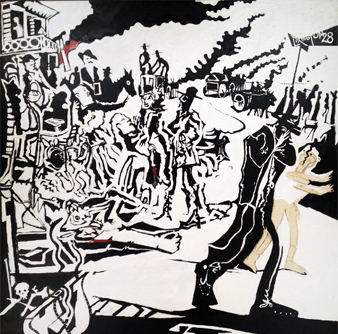
In "General Order No. 11," George Caleb Bingham uses symbolism to convey his view on the infamous 1863 order that upended the lives of many western Missourians. Courtesy of the State Historical Society of Missouri.
Missouri artist George Caleb Bingham’s General Order No. 11 has undergone a variety of interpretations since its completion in the late 1860s. Critics have interpreted it mostly as a vision of reconciliation and emancipation, though elements led some observers to find white supremacy undertones.
The oil painting is the centerpiece of “Remembering General Order No. 11” at the State Historical Society in Ellis Library through December. Also in the show are a drawing by Kansas City artist Fred Shane (1906-1990) of a Civil War-era raid on Lawrence, Kan., and an interpretation of Bingham’s painting by abstract artist James J. Froese (1936-2012). The exhibit commemorates the 150th anniversary of the infamous edict.
Union Gen. Thomas Ewing issued General Order No. 11 on Aug. 25, 1863, following multiple skirmishes between pro-Union Kansas residents and pro-Confederate Missourians. The order attempted to reduce the number of Confederate sympathizers in western Missouri to put an end to the borderline battles. But the order was a travesty, as it actually strengthened Confederate guerrillas as they raided the abandoned farmhouses for food supplies. Meanwhile, Union soldiers torched farmhouses and killed Missourians, many with Unionist sympathies. The order was repealed in 1864.
Despite his support for the Union, Bingham thought Order No. 11 was an unnecessary abuse of power. He conveyed his displeasure in the eponymous painting. To Bingham’s surprise, some 19th-century viewers believed the painting was pro-slavery and pro-Confederate propaganda. Bingham implies often that the painting is emancipationist, say many scholars.
Controversial Work
General Order No. 11 depicts Union soldiers confronting a slaveholding Missouri family. In the background, other Missouri families are shown fleeing as plumes of smoke rise from burning homesteads.
In a number of ways, Bingham signals that his painting is not to be read literally. One way is stylizing the characters by exaggerating gestures and expressions.
If the painting is read like a text, the left-to-right progression suggests a cause-and-effect narrative in which sequential action is represented simultaneously. The events pictured on the left lead to exile and desolation on the right. In this context, one can interpret the stately home and its besieged inhabitants as symbols of the antebellum past. The stiff and unmoving pose of the white-bearded head of the slave-holding household connects with the obsolete past. His ossified pose reflects impotence. No longer able to protect the women, children and slaves in his care, he is a failure — a Lear-like symbol of the antebellum era.
The black man and boy on the right of the canvas have created much speculation over the years. Southern apologists have said the father and son weep because plantation life served them well. But other critics offer a different view.
With head in hands, the man resembles Adam in Masaccio’s Renaissance fresco Expulsion from Eden. The black man is visualized as a new Adam and founder of a new history. The allusion implies a spiritual equality of races while also connecting slavery with original sin, a Christian doctrine often associated with slavery during the Civil War. During his second inaugural address, President Abraham Lincoln interpreted the war as atonement for the sin of slavery.
The Adam allusion continues. The black figures are cast out of their plantation life to make it on their own. They weep because the cards are decidedly stacked against them. The chaos of warfare led many enslaved people to leave their Missourian masters in 1863. But self-emancipation was fraught with danger, as some pro-Confederate guerrillas targeted former slaves with violence.
Union Gen. Clinton B. Fisk documented the hostility in a military report written in March 1865.
“There are many negroes with their families seeking homes, fleeing from their old masters and from fear of assassination by guerrillas,” Fisk wrote. “The bushwackers in some localities are murdering the freemen. The poor blacks are rapidly concentrating in the towns and especially at garrisoned places. My hands and heart are full….There is much sickness and suffering among them.”
Painting Influence
General Order No. 11 has been influential to modern artists. One was the late James J. Froese, who in 1968 became director of MU Art Extension and was an MU art professor until his retirement in 1992. Froese created Variation on Order No. 11 around 1970.

Bingham's painting was influential to 20th-century artists, such as the late James J. Froese, a one-time MU professor who created circa 1970 “Variation on Order No. 11."
It is significant that Froese focuses on Bingham’s two black figures on the right. While the white figures on the left of Froese’s picture create a muddled mass of positive and negative forms, the black figures are enlarged and distinguished.
The boy’s figure is sketchy; charcoal lines outline his form on raw white canvas. Froese may have recognized that Bingham’s focus on the black boy encourages viewers to consider the child’s future. In both Bingham’s and Froese’s age, the future of blacks in America remained uncertain.
This article was adapted from the essay “Toward an Emancipation Interpretation of George Caleb Bingham’s General Order No. 11” by Joan Stack, curator of the state collection for the State Historical Society of Missouri. The essay appeared in the summer 2013 issue of the Missouri Historical Review.

